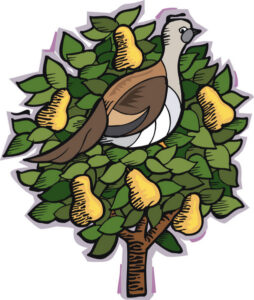
Hello fellow Christmas lovers!
If you thought since Christmas was over, I would fly back to The North Pole to stay then, you’re a silly goose! ♫♪♫ six geese a-laying, fiiiive golden riiiings… ♪♫♪ I have the very special honor of being the Scout Elf for The Christmas Shoppe, “Where it’s Christmas Everyday!” Plus, I have a great topic for us this week! Have you guessed it YET?
The 12 Days of Christmas!

Everyone knows to expect a partridge in a pear tree from your true love on the first day of Christmas … But when is the first day of Christmas?
The 12 days of Christmas, also known as Twelvetide, is a Christian festive celebration of the Nativity of Jesus Christ.
Twelvetide starts on Christmas Day, December 25, and finishes on January 5. (If you helped me study for my test of Christmas spirit last week, then you knew that already. 😉 I’m proud to announce I passed with flying reindeer! Thank you for your help!)
The 12 days signify the time in between the birth of Christ and the night before Epiphany, which is the day the Magi visited bearing gifts. This is also called “Twelfth Night.”
What does each day of Twelvetide mean?
Each day of Twelvetide has a different meaning:
The First Day of Twelvetide, is Christmas Day. This day’so focus is solely celebrating the birth of Jesus Christ.
The Second Day of Christmas is Boxing Day and is also known as St Stephen’s Day – he was the first Christian martyr (someone who dies for their faith).
The Third day of Christmas celebrates St John the Apostle. He was one of Jesus’s Disciples and friends and wrote the Book of Revelation.
The Fourth Day of Christmas is the Feast Of The Holy Innocents – the day when people remember all of the baby boys who were killed by King Herod in his search to kill the Baby Jesus.
The Fifth Day of Christmas is remembering St Thomas Becket – he was the Archbishop of Canterbury in the 12th Century and was killed on December 29 1170 for challenging the King’s authority over the church.
Today is The Sixth Day of Christmas which remembers St Egwin of Worcester, who died on December 30 717, he was known as the protector of orphans and the widowed.
The Seventh Day of Christmas (New Year’s Eve) celebrates Pope Sylvester I. (In some central and eastern European countries including Austria, the Czech Republic, Germany, Hungary, Israel, Italy, Poland, and Switzerland, New Year’s Eve is still known as Silvester.)
The Eighth Day of Christmas falls (New Year’s Day) celebrates Mary, the Mother of Jesus.
The Ninth Day of Christmas honors St Basil the Great and St Gregory Nazianzen – two important fourth century Christians.
The Tenth Day of Christmas is the Feast of the Holy Name of Jesus – this marks the day Jesus was named in the Jewish Temple.
The Eleventh Day of Christmas celebrates St. Elizabeth Ann Seton, the first American saint, who lived in the 18th and 19th centuries. (In the past it also celebrated the Feast of Saint Simeon Stylites who spent 37 years living on a small platform on top of a pillar)
The Twelfth Day of Christmas, January 5, is also known as Epiphany Eve – it’s the day before January 6 which is known as the Epiphany. (Also celebrated is St. John Neumann who was the first Bishop in American.)
Twelfth Night
The Elves of The North Pole have passed down generations of stories of the different celebrations and customs of Twelfth Night recorded over history.
Twelfth Night was a big time of celebration with people holding large parties. During these parties, often the roles in society were reversed with the servants being served by the rich people. (This dated back to medieval and Tudor times.)
At the start of Twelfth Night the Twelfth Night cake was eaten. This was a rich cake made with eggs and butter, fruit, nuts and spices. A dried pea or bean was cooked in the cake. Whoever found it was the Lord (or Lady) for the night. They led the celebrations and dressed like a King (or Queen). This tradition goes back to Roman celebrations.
During Twelfth Night, lots of games were played including a game where the players would be tossing an egg between two people moving further apart during each throw – drop it and you lose. (Have you ever played that game with a waterbaloon? Would you want to play it with an egg?)
 Many people also went Wassailing on Twelfth Night. Originally, the wassail was a drink made of mulled ale, curdled cream, roasted apples, eggs, cloves, ginger, nutmeg and sugar. The Christmas Shoppe carries Aspen Mulling spices. It has many great uses, cider, pancake batter and it also makes a mean WASSAIL!
Many people also went Wassailing on Twelfth Night. Originally, the wassail was a drink made of mulled ale, curdled cream, roasted apples, eggs, cloves, ginger, nutmeg and sugar. The Christmas Shoppe carries Aspen Mulling spices. It has many great uses, cider, pancake batter and it also makes a mean WASSAIL!
In many countries it’s traditional to put the figures of the Wise Men/Three Kings into the Nativity Scene on Epiphany Eve ready to celebrate Epiphany on the 6th of January. It’s also traditional to take your Christmas decorations down following Twelfth Night.
So, I want to know! How long do you leave your Christmas decorations up?
I hope that your Christmas was magical! May 2018 bring blessings into your home.
Thank you for spending some time with me! See y’all next year!
~S’more the Elf
Previous S’more Blog ~~~~ Next blog coming soon!
We are oh, so social! Follow us on Facebook, Pinterest, and Instagram!
Get the latest S’more Blog in your email by clicking HERE!

